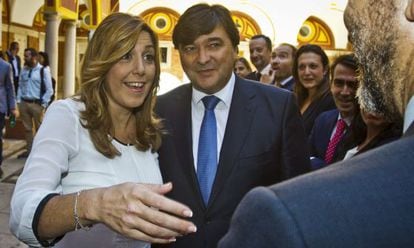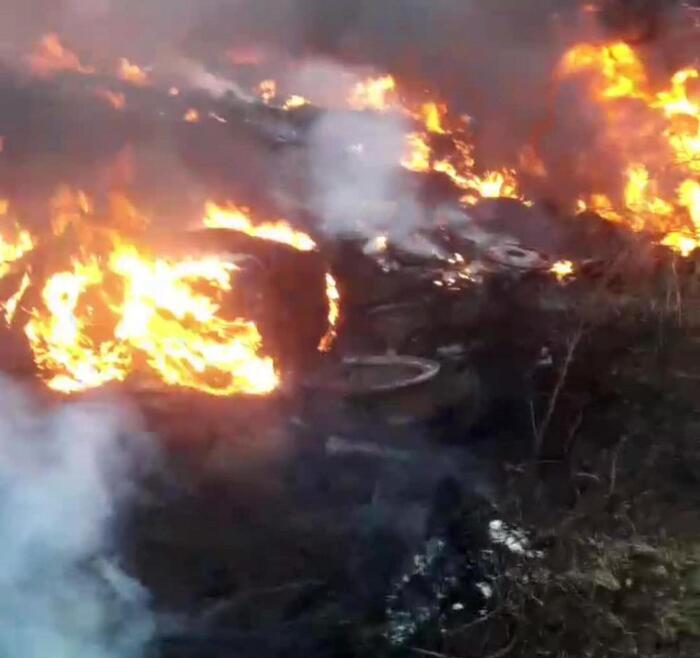Scientists have been studying Huelva's phosphogypsum pools since 1998 -with 120 million tons of toxic waste next to the city- and their conclusions are clear: the plan planned by the company Fertiberia to bury them under a meter of earth and clay implies a serious risk of collapse, an accident that would bring catastrophic consequences for the Andalusian city, with 150,000 inhabitants and located just 500 meters from this industrial waste.
However, the unanimous opinion of science has not pleased the City Council (PSOE), which in 2015 commissioned the experts to carry out their analyzes and has been hiding them in a drawer for a year and a half.
“Let's bury the science because we don't like what it says, and let's forget about phosphogypsum despite the demonstrated structural stability problem.
Even when?
We don't know when the perfect storm will occur, but we are in a unique place in the world because there are no piles of phosphogypsum on a marsh”, denounces one of the researchers from the University of Huelva.
The scientist demands anonymity because he was forced to sign a confidentiality clause that prohibits him from disseminating information without the authorization of the Consistory.
The conclusions contrary to the Fertiberia plan have not been disclosed to the Ministry for the Ecological Transition, which gave its approval to the restoration project in 2020, nor to the Andalusian Government, which finalizes its environmental permit so that before the end of the year they can begin the works.
In this way, the Administrations plan to authorize a plan valued at 66 million and that will last a decade, against the scientific research carried out between 2015 and 2020.
The City Council, which issued an urban compatibility study for the project, refuses to explain why it has avoided disclosing the alerts from the 20 scientists from the universities of Huelva and Granada, the Higher Center for Scientific Research (CSIC), the Geological and Mining Institute ( IGME) and ISGlobal.
The socialist mayor, Gabriel Cruz, commissioned the studies in 2015, but after the ministry's declaration of favorable impact in September 2020, he convened the last meeting of the participation body - to which the scientists report - on December 29 of that year.
That day, two scientists warned of the danger of collapse and contamination that Fertiberia's plan entails before political parties, unions and neighborhood and environmental groups.
Since then, silence.
“I feel neglected by the City Council, I thought that science was going to influence the restoration and I don't know what role we have played.
We were created for political reasons, but the decision had already been made”, laments another university researcher, who also claims anonymity to avoid a possible lawsuit.
The vice-rector for Research and Transfer of the University of Huelva and president of the group of experts, José Rodríguez, assures that the Consistory -which has failed to fulfill its public commitment to inform the public every six months- plans to convene the scientists before the end of summer : "We will write a report and from there the delicate question is to what extent we will make it public due to the confidentiality commitment".
Water bypass canal in the phosphogypsum pools, with the city of Huelva in the background. PACO PUENTES
After the ministry's positive environmental impact statement, a month ago the Nuclear Safety Council (CSN) gave its approval to the burial of phosphogypsum because it offers radiological safety, and now the ball is in the court of the Board.
Its integrated environmental authorization will check if there is a contaminant emission into the atmosphere, the discharge of water and the possible impact on people's health.
"We already have the dish served from the ministry and we cannot dispute it," comment sources from the Ministry of Sustainable Development, whose delegation in Huelva, without experts in geotechnics, geodynamics and hydrology, will foreseeably give its approval to the restoration plan this summer.
After five decades of accumulation of waste from the manufacture of fertilizers that ended in 2010, scientists have studied the structural stability of the rafts, their progressive sinking due to the pyramids of up to 25 meters that accumulate, the pollution caused by the tides in the Rio Tinto estuary and how the stacking would react to a possible earthquake or tsunami.
The conclusions about the planned restoration plan are disturbing.
"The deformation of the supporting substrate is continuous over time, as is the sinking of the front zone of the stack in zone 2. This clearly confirms the serious risk of collapse of the stack," warns the latest study by the Subsoil Geology group and Geotechnics from the University of Huelva.
The main threat comes from the stability of the ponds, which sink at high speed because they are settled under mud in a heterogeneous way, in certain areas with up to 25 meters of mud and others only five.
The collapse of the pile is "dizzying", in the words of a third researcher who also signed the confidentiality clause, from the Department of Geodynamics of the University of Granada, who has verified how at the same time that the rafts are depressed, the bottom of the channel rises.
"The vertical deformations reach 21.5 cm/year and accumulate movements of up to 80 centimeters in the monitored period", reflects the study of that university.
Copernicus, the Earth observation program of the European Commission, has been allowing this sinking to be consulted online for a few weeks.
The mayor of Huelva, Gabriel Cruz (PSOE), together with the former president of the Junta Susana Díaz, in 2019. Julián Pérez (EFE)
“As it sinks, either the structure will move or collapse in the direction of the channel [the mouth of the Tinto], creating a displaced block that would act as a dam in the estuary.
This would cause a shock wave and the waters of the Tinto [copper-colored and with heavy metals from the mines] would spread to the right towards Huelva and to the left, towards Palos and Moguer”, adds the first of the experts from the University of Huelva mentioned.
Thanks to high-resolution seismic, scientists have confirmed that there is migration of fluids from the base of the stack towards the area of lower pressure, which is the estuary channel.
“The basis of the [Fertiberia] project is that there is no migration of fluids.
The stress tests with encapsulated sample were swallowed by the Miteco [Ministry for Ecological Transition] because the engineer understood that in impermeable materials such as mud there is no migration of lateral fluids.
The problem is that here the substrate is inclined, there is a slope”, warns this last scientist.
The best example of the instability that the marsh entails is the old bullring, near the rafts, which was declared in ruin and collapsed in the eighties.
The seismic activity of the marsh, of low to moderate magnitude, includes nearby faults that are active: "Earthquakes of high magnitude should not be ruled out, even if they have not yet been recorded," warns a study with data on the seismic activity of the area between 1900 and 2019, including an earthquake of 4.2 just 18 kilometers from the rafts, which occurred in 1956. Regarding the risk of tsunamis, the Department of Earth Sciences of the University of Huelva identified 14 marine earthquakes in the last 9,000 years in the Gulf of Cadiz thanks to drilling and analysis of marine deposits.
The last catastrophic one was that of Lisbon in 1755, but documentary collections also support those of 1531, 1013 and 881. “Between 400 and 500 years a tsunami arrives, the problem is that there is no exact and permanent periodicity.
When it reaches the shore,
Aerial view of the phosphogypsum stacking, with Huelva in the background.
PACO BRIDGES
In parallel, scientists have studied the contamination of the estuary and have confirmed that it is produced by the water that enters through the estuary and returns through the tidal channels, much more acidic and loaded with metals.
Only 9% of the leachate comes from the infiltration of the upper reservoir.
“The contribution of arsenic or cadmium is quite significant”, summarizes a fourth expert, from the Department of Mineralogy and Geochemistry of the University of Huelva, who has studied the environmental geochemistry of the ponds.
"Covering the surface of the ponds with a natural soil does not guarantee the cessation of the edge outlets that reach the estuary", warns the report of this department, which recommends monitoring, collecting and channeling all the waters towards a passive treatment system before from its discharge into the estuary of the Huelva estuary.
Also,
The experts met in 2020 with Fertiberia to study the hydrogeological model with the data collected over the last decades, but two years later, the company has still not provided them.
Asked about it, the firm has refused to explain its refusal to collaborate with the experts.
"It is very clear that once the Miteco pronounced itself, everything changed for the City Council," censors Francisco García, spokesman for Ecologists in Action.
The paradox of the scientific reports is that they were paid thanks to the Andalusian Board, which transferred funds for 200,000 euros in "two special actions" received by the University of Huelva.
In other words, the regional government subsidized knowledge that ultimately will not be able to influence the decision of its own Ministry of Sustainable Development because of the Huelva Town Hall.
The City Council, despite its initial commitment to contribute 100,000 euros a year to scientists, never transferred that money to said institution.
50% off
Exclusive content for subscribers
read without limits
subscribe
I'm already a subscriber


/cloudfront-eu-central-1.images.arcpublishing.com/prisa/3RB3CJFFOP3P65AULIJ7CSFBSY.jpg)









